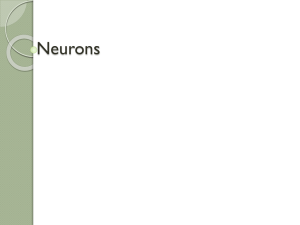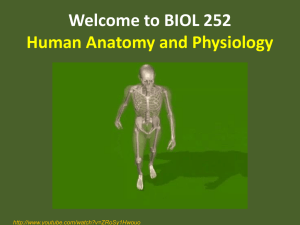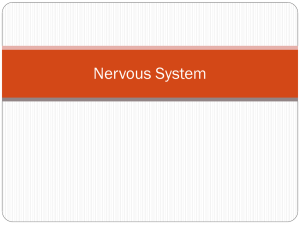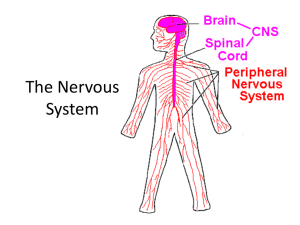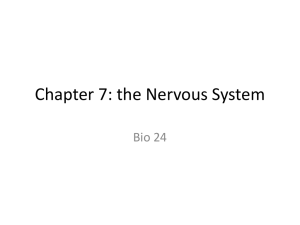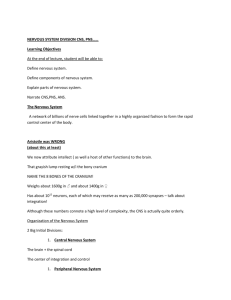HUMAN ANATOMY
advertisement
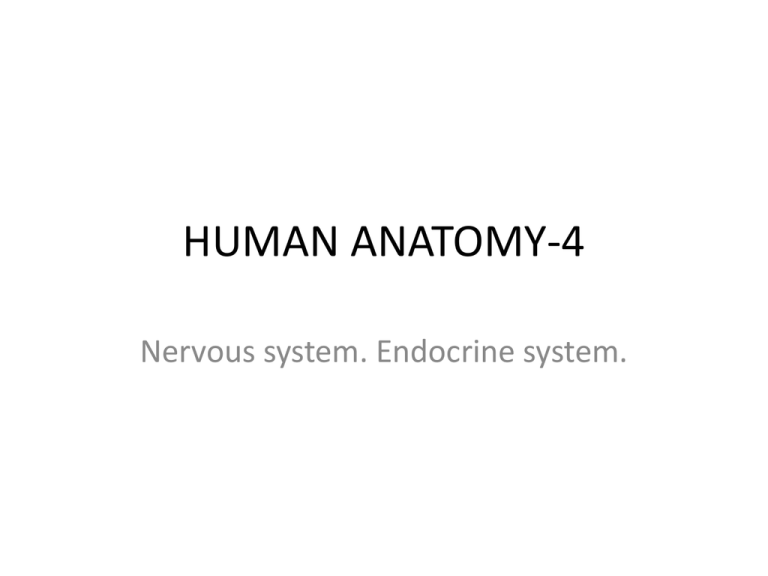
HUMAN ANATOMY-4 Nervous system. Endocrine system. General info • There are 2 body systems, which maintain internal coordination of trillions of cells: nervous system and endocrine system. • Nervous system sends electrical & chemical messages to cells • Endocrine system works by means of hormones, secreted to the blood. Nervous system – general info • Nervous System (NS) consists of 2 types of cells: • cell of nervous tissue - NEURON & • cell of connective tissue – GLIAL CELL. • So the nervous system is the mixture of two types of tissue, called neuroglia (p.164, fig.5,24). Neuron • Neuron, apart from its common for majority of other cells general cellular compartments, has 2 types of extensions: DENDRIT & AXON. • Dendrit – is a short and intensively branched extension, which receives signals from other cells. • Axon – is the long (sometimes up to the 1 m or more) extension, which sends outgoing signals to the cells. NEURON – physiologic properties These characteristics allow neurons to communicate. • Exitibility – they response to environmental stimuli • Conductivity – produced electrosignals propagate to various distances • Secretion – nerve endings secret neurotransmitters, that stimulates other cells. NEURON – functional classes (p.442, fig.12.3). • – sensory (afferent) neurons, present within organs to detect stimuli & send them to CNS • – motor (efferent) neurons, send signals from CNS to muscles & glands for action • – interneurons, comprise 90% of all neurons, present only in CNS. Glial cell • Glial cells occupy the most part of nervous system • Their major function is to support & protect nervous cells. • They resemble connective tissue cells and don’t transmit signals for long distances. Central & peripheral nervous systems • Neuroglia comprises nervous system, which consists of 2 departments: • Central Nervous System (CNS) & • Peripheral Nervous System (PNS) (p.440, fig.12.1). CNS is presented by 2 subdivisions: • BRAIN, located within the cranium, & • SPINAL CORD (located within vertebral channel) CNS & PNS – functional classification • PNS consists of 2 subdivisions: • SENSORY subdivision, which receives signals and • MOTOR subdivision, which sends outgoing signals. • Each of this parts has visceral (involuntary) and somatic (voluntary) parts. • Besides that visceral motor subdivision is comprised of SYMPATHETIC & PARASYMPATHETIC compartments (p.441, fig. 12.2). Autonomic nervous system • The sympathetic division tends to arouse the body for action, dominates at the daytime (& inhibit digesition) • The parasympathetic division tends to have a calming effect , dominates at the nighttime (& stimulate digestion) • Common name for these divisions is autonomic nervous system SPINAL CORD (p.480, fig.13.1) • Is a cylinder of nervous tissue, which spreads from the brain upto the 1st lumbar vertebra • Gives rise to 31 pairs of spinal nerves Has 4 regions: • cervical (C1 – C8), • thoracal (T1 – T12), • lumbar (L1 – L5) & • sacral (S1 – S5) BRAIN (p.513 fig.14.1) • Consists of 3 major parts: cerebrum, cerebellum, brainstem. • Cerebrum is the highest center for control of body functions & behavior • Proportions of body parts on motor cortex of the brain (p.542 fig.14.23). • • Cerebellum provides with balance & coordination • • Brainstem provides with breathing & heart beating centers. • 12 pairs of cranial nerves arise from the brainstem.

